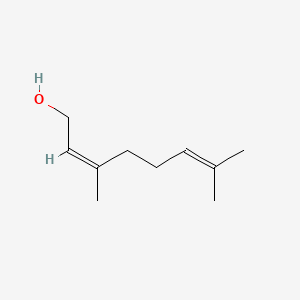| Authors | Title | Published | Journal | PubMed Link |
|---|---|---|---|---|
| Gilpin SJ et al. | Volatility of fragrance chemicals: patch testing implications. | 2009 Jul-Aug | Dermatitis | pmid:19804696 |
| Kim J et al. | Male-produced aggregation pheromone blend in Platypus koryoensis. | 2009 | J. Agric. Food Chem. | pmid:19170509 |
| Mendonça Ade L et al. | Antimicrobial activities of components of the glandular secretions of leaf cutting ants of the genus Atta. | 2009 | Antonie Van Leeuwenhoek | pmid:19214771 |
| Brunert D et al. | Odorant-dependent generation of nitric oxide in Mammalian olfactory sensory neurons. | 2009 | PLoS ONE | pmid:19430528 |
| Müller GC et al. | Efficacy of the botanical repellents geraniol, linalool, and citronella against mosquitoes. | 2009 | J. Vector Ecol. | pmid:20836800 |
| Faria JM et al. | Biotransformation of menthol and geraniol by hairy root cultures of Anethum graveolens: effect on growth and volatile components. | 2009 | Biotechnol. Lett. | pmid:19205895 |
| Lorenzi V et al. | Geraniol restores antibiotic activities against multidrug-resistant isolates from gram-negative species. | 2009 | Antimicrob. Agents Chemother. | pmid:19258278 |
| Jordan MD et al. | Odorant receptors from the light brown apple moth (Epiphyas postvittana) recognize important volatile compounds produced by plants. | 2009 | Chem. Senses | pmid:19293399 |
| Kigasawa K et al. | In vivo transdermal delivery of diclofenac by ion-exchange iontophoresis with geraniol. | 2009 | Biol. Pharm. Bull. | pmid:19336905 |
| Judzentiene A et al. | Analysis of essential oils of Artemisia absinthium L. from Lithuania by CC, GC(RI), GC-MS and 13C NMR. | 2009 | Nat Prod Commun | pmid:19768995 |
| Duchêne E et al. | A grapevine (Vitis vinifera L.) deoxy-D: -xylulose synthase gene colocates with a major quantitative trait loci for terpenol content. | 2009 | Theor. Appl. Genet. | pmid:19002427 |
| Tiwari M and Kakkar P | Plant derived antioxidants - Geraniol and camphene protect rat alveolar macrophages against t-BHP induced oxidative stress. | 2009 | Toxicol In Vitro | pmid:19135518 |
| Nunes IS et al. | Menthol and geraniol biotransformation and glycosylation capacity of Levisticum officinale hairy roots. | 2009 | Planta Med. | pmid:19156598 |
| Li G et al. | Total synthesis of (-)-5,6-dihydrocineromycin B. | 2009 | J. Org. Chem. | pmid:19115810 |
| Forester CD and Wells JR | Yields of carbonyl products from gas-phase reactions of fragrance compounds with OH radical and ozone. | 2009 | Environ. Sci. Technol. | pmid:19544855 |
| Leutou AS et al. | Microbial transformation of a monoterpene, geraniol, by the marine-derived fungus Hypocrea sp. | 2009 | J. Microbiol. Biotechnol. | pmid:19884773 |
| Khallaayoune K et al. | Efficacy of 1% geraniol (Fulltec) as a tick repellent. | 2009 | Parasite | pmid:19839268 |
| Barros LA et al. | In vitro larvicidal activity of geraniol and citronellal against Contracaecum sp (Nematoda: Anisakidae). | 2009 | Braz. J. Med. Biol. Res. | pmid:19787148 |
| George DR et al. | Toxicity of geraniol solution in vitro to the poultry red mite, Dermanyssus galinae. | 2009 | Parasite | pmid:20092065 |
| Vuts J et al. | Development of an attractant-baited trap for Oxythyrea funesta Poda (Coleoptera: Scarabaeidae, Cetoniinae). | 2008 Sep-Oct | Z. Naturforsch., C, J. Biosci. | pmid:19040118 |
Nerol
Nerol is a lipid of Prenol Lipids (PR) class. The involved functions are known as Odorant, Anabolism, Diastasis, Metabolic Inhibition and Oxidation. Nerol often locates in germ tube. The related lipids are Octanols, Pinene, Hexanols, ethyl butyrate and ethyl hexanoate.
Cross Reference
Introduction
To understand associated biological information of Nerol, we collected biological information of abnormalities, associated pathways, cellular/molecular locations, biological functions, related genes/proteins, lipids and common seen animal/experimental models with organized paragraphs from literatures.
What diseases are associated with Nerol?
There are no associated biomedical information in the current reference collection.
No disease MeSH terms mapped to the current reference collection.
PubChem Associated disorders and diseases
What pathways are associated with Nerol
There are no associated biomedical information in the current reference collection.
PubChem Biomolecular Interactions and Pathways
Link to PubChem Biomolecular Interactions and PathwaysWhat cellular locations are associated with Nerol?
Visualization in cellular structure
Associated locations are in red color. Not associated locations are in black.
Related references are published most in these journals:
| Location | Cross reference | Weighted score | Related literatures |
|---|
What functions are associated with Nerol?
Related references are published most in these journals:
| Function | Cross reference | Weighted score | Related literatures |
|---|
What lipids are associated with Nerol?
Related references are published most in these journals:
| Lipid concept | Cross reference | Weighted score | Related literatures |
|---|
What genes are associated with Nerol?
There are no associated biomedical information in the current reference collection.
What common seen animal models are associated with Nerol?
There are no associated biomedical information in the current reference collection.
